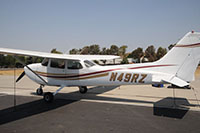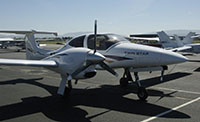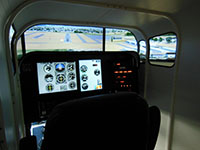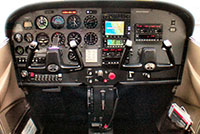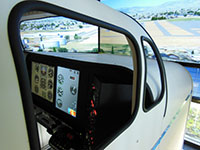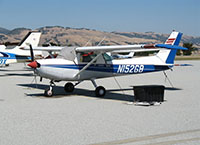 |
Welcome to Ahart Aviation Services
|
Becoming a Pilot
Have you ever when seeing small aircraft flying over head, looked up in wonder and said to yourself, “someday I want to be up there”? Now you’ve decided that you are ready to take that step and become a pilot! But, you’re not sure what to do next, what is required to achieve this goal, and how to get started. In this section, we’ll attempt to answer those questions and more.
The very first thing we recommend to anyone wanting to learn how to fly is to schedule an introductory flight. This is a discounted 45-minute flight (usually in a four seat aircraft) that allows you to experience flight in a small aircraft for the first time. Often the instructor will have the student do the takeoff and fly hands-on around the local area, allowing the student to attempt turns, climbs, and descents. We finish off the flight with a logbook and your first official entry! Generally, these flights will “hook” the potential student.
The next step is to meet with one of our owners or staff members, so they can show you around the facility, discuss the program, and make a schedule that will work with your existing schedule. They will then assign you to an instructor and schedule the first couple of lessons for you. At this point you are an unofficial student pilot (we will get to the official student pilot qualifications soon).
As a student pilot you will need the following supplies:
- Jeppesen Private Pilot Manual
- Jeppesen Maneuvers Manual
- This helps you remember how to fly the plane under different circumstances
- FAR/AIM
- Federal Aviation Regulations/Airman's Information Manual
- Written Study Guide
- To prepare for the FAA written test
- Practical Test Standards
- These describe what you need to accomplish during your training
- Headset (we generally have loaners available)
- So you can easily hear your instructor and people on the radio
- Kneeboard
- To hold important documents like charts, flight plans, and paper to write down instructions
- E6B (or electronic flight computer)
- Used to calculate altitude differences, speed, wind, etc.
- Plotter
- Used to calculate direction and distance to points on a sectional chart
- Flight Bag
- So you can hold all this stuff!
There are many other supplies that you may decide to purchase as you go through your training, but this should be enough to get you started. Fortunately, we sell a kit in a flight bag that includes all of these items (except the headset and kneeboard, which are sold separately).
You will also need to obtain an FAA Medical Certificate, which is issued by an FAA medical examiner (click here for a list of medical examiners in the area).
The medical certificate is also your Student Pilot License and when you make your appointment you will want to tell the medical staff that you are a student pilot and will require the student pilot license. You can apply for a 1st class, 2nd class or 3rd class medical certificate. If you are considering a career in aviation you may want to apply for the 1st class medical to be sure that you do not have any medical condition that may prevent you from obtaining a 1st class medical. For most student pilots, however, a 3rd class medical is all that they will need.
A student’s training at Ahart Aviation is divided into three stages, appropriately designated as Stage I, Stage II and Stage III.
Stage I
Also known as the pre-solo stage, it is comprised of several maneuvers all of which are designed to teach a student pilot to fly safely. You will learn to takeoff, climb, make turns, descend and land (under various conditions); fly the airplane at minimum controllable airspeeds; stall and recover the aircraft both with and without power; fly steep bank turns; fly ground reference maneuvers while managing various wind conditions; and handle emergency situations. Once you have become proficient in these maneuvers and demonstrate the ability to fly and land safely with no input from your instructor, you will be scheduled for a Stage I exam. Following this, you will be eligible for your first solo flight.
Stage II
This stage, the cross-country phase, is designed to teach the student to plan a flight and fly from one airport to another using ground visual reference points and/or tracking VORs while using the radios in the plane. During this stage, you will continue to practice the maneuvers you learned in Stage I, but now, you will be practicing them on your own.
Once you have demonstrated your ability to fly safely from your home airport to another airport with no input from your instructor, you will be prepared for the Stage II exam. Following its completion, you will then fly solo cross-country trips.
Stage III
This wrap-up stage consists of flying your solo cross countries and practicing your maneuvers (both solo and with your instructor). Once you and your instructor decide that you are ready for the FAA check-ride, you will do a Stage III exam, and then you will go for your oral and practical exams with an FAA-designated examiner.
Requirements for the Private Pilot Certificate
- Student Pilot License with minimum of 3rd class medical
- 40 hours of flight experience including at least 10 hours of solo flight experience
- 5 hours of solo cross-country flight experience
- FAA Written Exam (score 70% or higher)
- Read, speak and understand the English language
- 16 years old to solo
- 17 years old to take the practical exam
- Satisfactory completion of a practical exam including an oral and flight portions with an FAA-designated examiner
The cost for completing the program will vary by individual skill level, how many days per week you are able to commit to training, and the kind of airplane you choose to train in. Generally, the total cost will run between $6,000 up to $9,000 with consistent training (on again/off again training tends to take longer and thus be a more expensive)
Copyright 2012, Ahart Aviation Services Inc. in collaboration with Komanetsky Aviation, LLC
